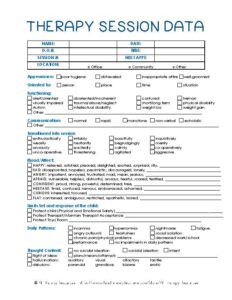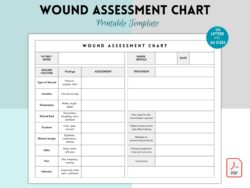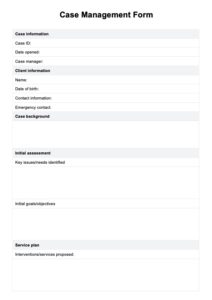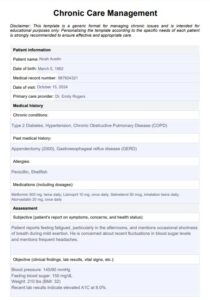Running a physician’s office lab (POL) comes with a lot of responsibility, and keeping accurate records is paramount. Think of it like this: your lab tests are providing crucial clues for patient diagnoses and treatment plans. Without a clear, consistent system for documenting these tests, you risk misinterpreting results, facing compliance issues, and ultimately, compromising patient care. That’s where a solid physician office lab testing documentation template comes in handy.
A good documentation template isn’t just about ticking boxes. It’s about creating a streamlined process that ensures everyone on your team is on the same page. It helps you track everything from the moment a sample arrives to the final interpretation of results. This thoroughness can protect your practice from errors, streamline audits, and provide better data for informed clinical decisions. It’s like having a well-organized lab notebook, but in a digital and easily accessible format.
This article dives into the ins and outs of creating and using a physician office lab testing documentation template. We’ll explore the key components, the benefits of using one, and how to customize it to fit the specific needs of your practice. By the end, you’ll have a clear understanding of how to implement a robust documentation system that improves accuracy, efficiency, and compliance in your POL.
Why is a Detailed Physician Office Lab Testing Documentation Template Essential?
Imagine trying to bake a cake without a recipe. You might get something edible, but it’s unlikely to be consistent or particularly good. Similarly, conducting lab tests without a standardized documentation template can lead to inconsistent results, errors, and a whole lot of frustration. A well-designed template provides a clear, step-by-step guide for every test, ensuring that everyone follows the same procedures and records the same information.
The benefits extend far beyond simple consistency. Think about compliance. Labs are subject to rigorous regulations, and accurate documentation is crucial for demonstrating adherence to these standards. A proper template ensures you’re capturing all the necessary data points required by regulatory bodies, making audits a breeze. Without it, you risk fines, sanctions, or even losing your lab accreditation. No one wants that!
Furthermore, a comprehensive documentation template facilitates better communication between lab personnel and physicians. Clear, concise records make it easier for physicians to interpret test results and make informed clinical decisions. It’s like having a clear translation of the lab’s findings, preventing misinterpretations that could lead to incorrect diagnoses or treatments. Time is of the essence, and the more accurate and standardized information there is, the faster care can be administered.
Consider also the value of data analysis. With a structured documentation system, you can easily track trends in test results, identify potential quality control issues, and assess the effectiveness of your lab procedures. This data-driven approach allows you to continuously improve your lab operations and provide even better patient care. Think of it as using past performance data to optimize your future strategies.
Finally, a good template acts as a training tool for new lab staff. By providing a clear and consistent framework for documenting tests, you can quickly onboard new employees and ensure they’re following established procedures. This reduces the risk of errors and ensures that everyone is contributing to the quality of your lab’s output. It streamlines onboarding processes and eliminates ambiguity in performing tasks.
Key Components of an Effective Physician Office Lab Testing Documentation Template
A successful physician office lab testing documentation template isn’t just a blank form; it’s a carefully designed tool that captures all the relevant information for each test performed. What exactly should be included? Let’s break it down.
First and foremost, patient identification is critical. This includes the patient’s name, date of birth, medical record number, and any other relevant identifying information. This seems obvious, but accuracy here is paramount to avoid mixing up results between patients. Think of it as the foundation of your entire documentation process; without it, everything else is built on shaky ground. Also document the name of the physician that ordered the testing.
Next, you need to document the details of the test itself. This includes the name of the test, the date and time it was performed, the lot number and expiration date of any reagents used, and the name of the technician who performed the test. These details are essential for tracking the validity of the test and for troubleshooting any potential problems. Consider it like a paper trail for accountability.
The template should also include space for recording the test results. This might be in the form of numerical values, qualitative descriptions, or images. It’s important to specify the units of measurement and the normal reference range for each test. This ensures that the results are clear and easily interpretable by physicians. Make sure the layout is very easy to read.
Finally, include a section for any notes or comments. This is where you can record any deviations from the standard procedure, any unusual observations, or any other information that might be relevant to interpreting the test results. This can be a lifesaver when trying to troubleshoot a problem or understand an unexpected result. This way you can explain something right away instead of wondering what could have gone wrong.
Beyond the specifics, consider the overall design of your template. It should be clear, concise, and easy to use. Use a consistent format and avoid using jargon or abbreviations that might be confusing. The goal is to create a tool that is both informative and user-friendly. Consider a digital solution that saves data on the cloud so that everyone can view, read, and collaborate on the information.
Ultimately, it’s about creating a system that works for your specific needs. By carefully considering the key components and tailoring your template to your practice, you can create a valuable tool that improves accuracy, efficiency, and compliance in your POL. Your physician office lab testing documentation template should constantly evolve with improvements.
Maintaining a well-organized lab is key to providing top-notch patient care and keeping your practice in good standing. A small investment in a good system can pay dividends in terms of efficiency, accuracy, and peace of mind.
With the right systems and documentation in place, your POL can be a seamless, reliable, and invaluable asset to your practice and, most importantly, to your patients.



